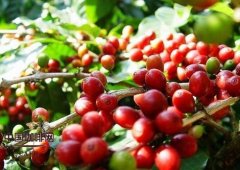Judgment of coffee grinding thickness thick and fine coffee powder brewing coffee
Generally speaking, when we judge the degree of grinding of coffee, we will combine some commonly used particles in life to make auxiliary judgments, such as sugar, salt, flour and so on.
In the relevant materials of SCAA (American Fine Coffee Association), there is a more accurate description.

With regard to the grinding thickness of coffee powder, the American Fine Coffee Association gives the following suggestions according to different coffee brewing utensils:
1. French pressure: each coffee is ground into 100,300 coffee powders, about diameter 0.7mm powder, that is, about the size of No. 2 sugar particles.

Filter: each coffee is ground into 500,800 coffee powder, about diameter 0.5mm powder, that is, about coffee with sugar (fine granulated sugar) particle size.

Saifeng (siphon pot): each coffee is ground into 1000-3000 coffee powder, about diameter 0.35mm powder, that is, about the size of food refined salt particles.

Espresso (Italian concentrate): each coffee is ground into 3500 coffee powders, about the diameter of 0.05mm powder, that is, about the size of flour particles.


The pictures come from the Internet, and the text has been sorted out and released.
Brian
Important Notice :
前街咖啡 FrontStreet Coffee has moved to new addredd:
FrontStreet Coffee Address: 315,Donghua East Road,GuangZhou
Tel:020 38364473
- Prev

A brief introduction to coffee producing areas-the difference between Ethiopian boutique coffee and ordinary coffee
Ethiopia is a landlocked country in northeast Africa. It is bordered by Djibouti and Somalia to the east, Sudan and South Sudan to the west, Kenya to the south and Eritrea to the north. The plateau accounts for 2% of the total area of the country, with an average elevation of nearly 3000 meters, which is known as the roof of Africa. Ethiopia is the birthplace of the famous Arabica coffee beans, which has been maintained to this day.
- Next

# counter-cultural Coffee # Coffee varieties that teach you Coffee interpretation of Common acronyms for Raw beans
Pay attention to the raw bean information, in addition to the clear name of the country and region, there are often many acronyms inside the label. When you meet for the first time, you often don't know what to say: DP: Dry Process, dry EP: European Preparation, European standard. It is common in Central and South America. It means that, on the basis of the classification of raw beans, in order to meet the special needs of some European raw bean merchants
Related
- Beginners will see the "Coffee pull flower" guide!
- What is the difference between ice blog purified milk and ordinary milk coffee?
- Why is the Philippines the largest producer of crops in Liberia?
- For coffee extraction, should the fine powder be retained?
- How does extracted espresso fill pressed powder? How much strength does it take to press the powder?
- How to make jasmine cold extract coffee? Is the jasmine + latte good?
- Will this little toy really make the coffee taste better? How does Lily Drip affect coffee extraction?
- Will the action of slapping the filter cup also affect coffee extraction?
- What's the difference between powder-to-water ratio and powder-to-liquid ratio?
- What is the Ethiopian local species? What does it have to do with Heirloom native species?

